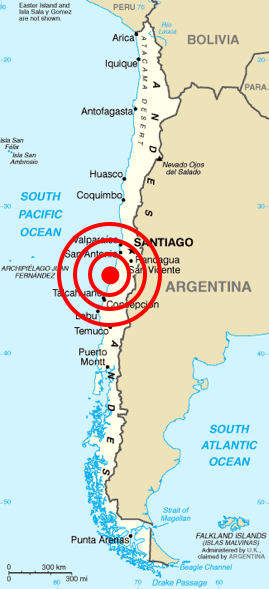2010 Chile earthquake
 Damaged sustained by a building in Concepción, located around 100 kilometres south of the epicenter. | |
 | |
| UTC time | 2010-02-27 06:34:12 |
|---|---|
| ISC event | 14340585 |
| USGS-ANSS | ComCat |
| Local date | 27 February 2010 |
| Local time | 03:34:12 CST (UTC-03:00) |
| Duration | 3 minutes |
| Magnitude | 8.8 Mww |
| Depth | 35 km (22 mi) 30.1 km (19 mi) |
| Epicenter | 35°54′32″S 72°43′59″W / 35.909°S 72.733°W 36°17′24″S 73°14′20″W / 36.290°S 73.239°W |
| Type | Megathrust |
| Areas affected | Chile |
| Max. intensity | IX (Violent) |
| Peak acceleration | 0.65 g |
| Tsunami | 24.1 m (79 ft) |
| Casualties | 525 dead, 25 missing[1] |


The 2010 Cauquenes earthquake was an earthquake that happened off the coast of Maule region of Chile, near Cauquenes, on February 27, 2010, at 03:34:12 local time (06:34:12 UTC). It is said to have lasted between ten and thirty seconds.[2] At first, its magnitude was reported to be between 8.3 and 8.5 on the Moment magnitude scale, but this was later corrected upwards, to be at 8.8 of that scale.[3] It was the strongest earthquake in Chile since the magnitude 9.5 1960 Valdivia earthquake, and the strongest earthquake worldwide since the 2004 Indian Ocean earthquake.[4]
The epicenter of the earthquake was offshore from the Maule Region, approximately 8 km west of Curanipe and 115 km north-northeast of Chile's second largest city, Concepción.[5] Also, the epicenter is less than 20 km due east from that of the 1960 Valdivia earthquake. Other cities exposed to Mercalli intensity scale intensity VIII (Destructive) shaking were Arauco, Lota and Constitución.[6]
The earthquake was also felt in the Chilean capital Santiago as well as in some Argentinean cities.[7] Tsunami warnings were issued in 53 countries.[7] Michelle Bachelet, President of Chile, declared a "state of catastrophe". She also confirmed the deaths of at least 795 people.[8][9]
Chile was hit by another earthquake in March 11, 2010, with epicenter in the coastern town of Pichilemu, Province of Cardenal Caro, almost 200 kilometers from Santiago de Chile. It was MW 6,9 in the Richter scale.

References
[change | change source]- ↑ Subsecretaría del Interior de Chile (31 January 2011). «Informe final de fallecidos y desaparecidos por comuna» Archived 14 November 2012 at the Wayback Machine
- ↑ Patrick Sawer (February 27, 2010). "Huge earthquake hits Chile". The Daily Telegraph. Retrieved February 27, 2010.
- ↑ "USGS Earthquake Details". United States Geological Survey. Archived from the original on November 1, 2010. Retrieved February 27, 2010.
- ↑ "Historic World Earthquakes". Earthquake.usgs.gov. United States Geological Survey. November 23, 2009. Archived from the original on January 30, 2016. Retrieved February 27, 2010.
- ↑ "Magnitude 8.8 – Offshore Maule, Chile". United States Geological Survey. February 27, 2010. Archived from the original on April 10, 2010. Retrieved February 27, 2010.
- ↑ "PAGER – M 8.8 – OFFSHORE MAULE, CHILE". Earthquake.usgs.gov. Retrieved February 27, 2010.
- ↑ 7.0 7.1 "Tsunami After Major Earthquake Hits Chile". Sky News. February 27, 2010. Retrieved February 27, 2010.
- ↑ David Batty (27 February 2010). "Deadly earthquake hits central Chile". The Guardian. Retrieved 27 February 2010.
- ↑ "Death toll in Chile earthquake rises to 78". RTÉ News. 27 February 2010. Retrieved 27 February 2010.